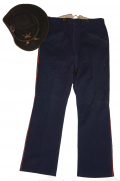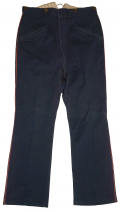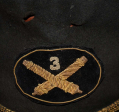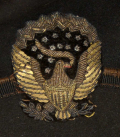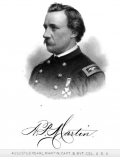site search
online catalog
FANTASTIC ID’D SLOUCH HAT AND OFFICER’S TROUSERS OF CAPT. AUGUSTUS PEARL MARTIN, 3rd MASS LT BATTERY, CHIEF OF 5th CORPS ARTILLERY: HE POSTED THE GUNS ON LITTLE ROUND TOP! WOUNDED IN ACTION; THREE BREVETS
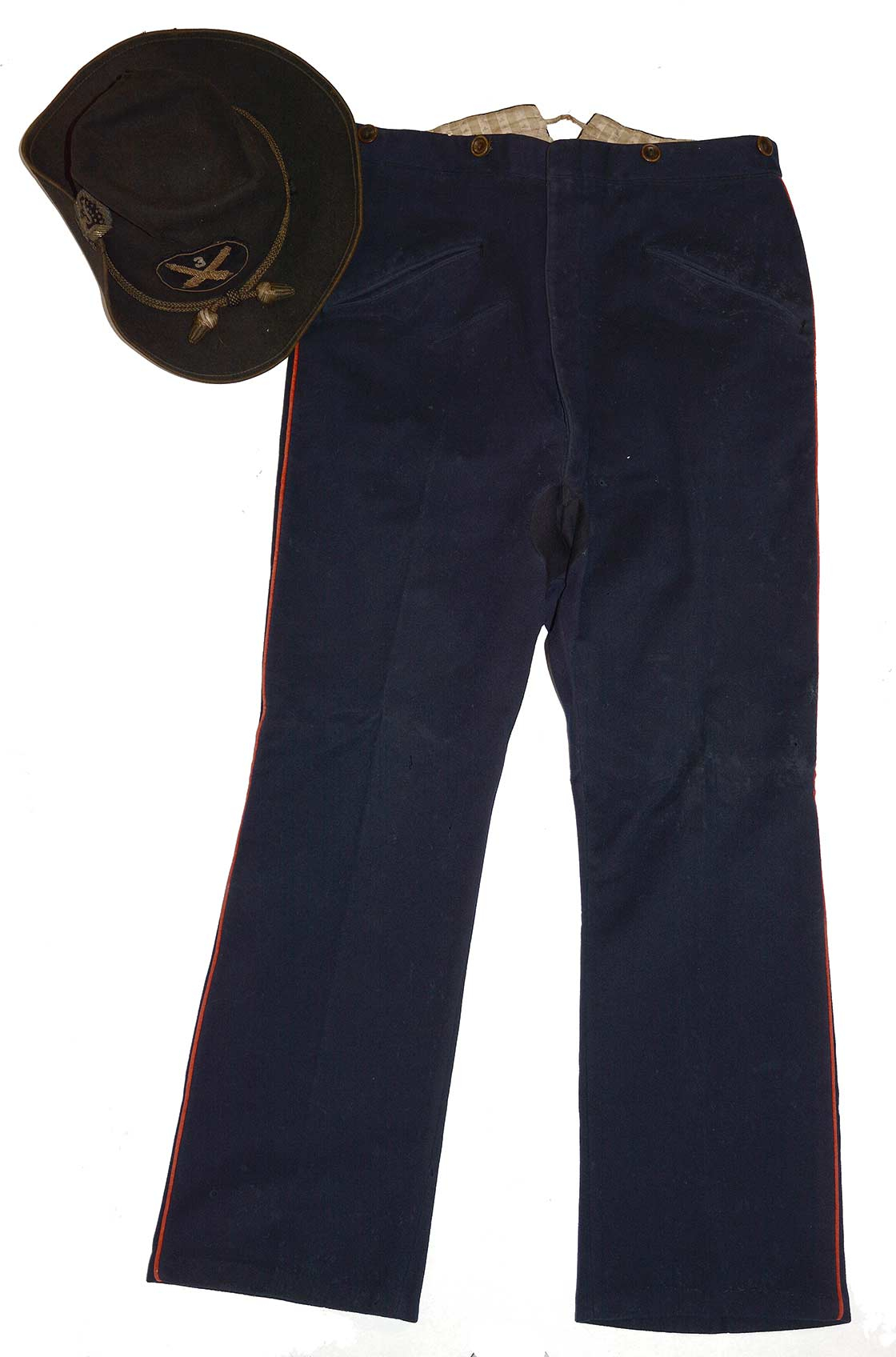
$12,500.00 SOLD
Quantity Available: None
Item Code: 1179-360
Capt. Augustus Pearl Martin of the 3rd Mass. Light Battery was put in command of the Fifth Corps artillery brigade on June 16, 1863. Little over two weeks later he was leading three of his batteries into action with Barnes’s Division and riding beside Lt. Hazlett of Battery D 5th US as the two decided to place guns on the crest of Little Round Top. By some accounts it was Gen. Warren’s suggestion. In Martin’s own telling it was his and Hazlett’s idea, and he did not encounter Warren until Hazlett’s guns, manhandled into position at the top of the hill by the artillerymen and drafted infantry, were already in position, prompting Warren to exclaim, “Martin, how in hell did you get those guns up here?” (By one account it took thirty men to physically lift one of the guns into place.) Whatever the exact sequence of events it was a critical moment in the battle and A.P. Martin was there in the middle of it.
The group consists of Martin’s officer’s hat and trousers. Both have great eye appeal as well as history.
Trousers: These are artillery officer’s trousers, a medium blue wool, lined in the waistband and upper rear with pockets on either side, and with red piping in the outer seam of each leg. The trousers are not reinforced, but clearly designed for a mounted officer. The slash pockets on either side of the front are located well below the waist and a small watch pocket is set below rather than above the pocket on the wearer’s right, all suiting an officer sitting in a saddle, as is an extra piece of cloth sewing into the lower front of the crotch, below the fly, exactly where the rider would be rubbing against the pommel of the saddle. All six suspender buttons are in place as are the hook and eye at top of the fly and two of the three fly buttons. The trousers have light scattered pencil point moth nips and moth tracking that has taken some of the nap, but these are relatively small the underlying fabric has good color, making them hard to spot in any case. The trousers are solid and have good color. The upper back has a typical adjusting belt and the V-notch at the rear waist has a short cord connecting the two upper points of the V. Martin’s initials, “APM” appear twice inside, once on each pocket. On one pocket they have been crossed out, as has a later small number, perhaps a museum or historical society inventory number. The initials “J.L.” appear in block letters, perhaps a collector or descendant. Martin’s own initials match exactly a signed CDV image of him and records in his service file- characteristically writes the “P” with a very small loop and flourish to the left, making it appear at first glance like a J.
Hat: Martin’s officer’s slouch is worth the price of admission on its own. As you want to see in a period hat, the body is soft and supple, the edge is bound, and the interior features a tall 2.5 inch black sweatband, and has a red silk lining above that with a drawstring. If worn the top pushed up it would be about 6.5 inches tall. Martin wore it with top pushed in, making it about 5 inches tall. The color is excellent. We see just three very short tears, really slits, on the front of the crown, about .25 inch with no fabric missing: two about an inch below the top edge and one along the top edge to the right, and two more at about the same level on the back, one .25 inch and one .50 inch. In all cases there seems to be no fabric missing and these slits close up so as to be very hard to spot. They are likely the result of repeatedly picking the hat up, or putting it on and off, by taking hold of the crown, a natural gesture, the wear being where one’s fingers would grasp it. The red silk lining shows some fading and soiling, but is all there. The sweatband has some short cracks along the lower edge and two small missing pieces, one about 1.5 by .5 inches and the other about 1 inch by .5. This does not affect the integrity of the sweatband, which is firmly in place and shows nice surface and color.
The hat follows the general specifications of an officer’s dress hat: black with one side turned up and secured by a gold bullion embroidered side eagle sewn into place on the wearer’s right. The insignia preserves lots of gilt finish to the eagle, the ribband curling from its beak, and sunburst overhead. The stars are silver on the black velvet ground and the arrows and olive branch in its claws appear to have been made of silver bullion thread with gold highlights. The badge was carefully trimmed along the edges, eliminating a large oval patch that on some hats seems out of proportion. The front insignia is full size, a 3 ½ by 2 ¼ inch oval of black velvet with a gilt jaceron wire border and gold bullion embroidered cross cannon barrels with a silver embroidered “3” in the upper angle. The insignia is semi-bright- slight subdued age toning only and no oxidation or “zincing out” in collector jargon. The black and gold officer’s hat cord is still in place and has good color also. The black netting is in place on the tops of the acorn ends, but missing from the lower portion, allowing the gilt thread to loosen in a couple of spots.
Born in 1835, Martin had prewar artillery experience in the Boston militia and did three month’s service at the beginning of the war with Cook’s 1st Battery L.A., M.V.M., enlisting formally on April 20, 1861, the day the battery was ordered to be ready to move, which it did that night, arriving the next morning by rail in New York, at Fortress Monroe by boat on the 23rd, and Annapolis on the 24th. On May 4 they were posted to the Relay House, guarding the railroad, and served there, with intervals in Baltimore until mustering out August 2 and returning to Boston the next day. They had prepared and left Boston so quickly that they were not even formally mustered into U.S. service until May 18.
Members of Cook’s Battery formed the nucleus of the 3rd Mass. Battery of Light Artillery, with Martin receiving a commission as one of the battery’s First Lieutenants Sept. 5, 1861. He was promoted to Captain and battery commander on November 28 and very well regarded by his men and by superior officers. At one point he was offered the colonelcy of a heavy artillery unit that would serve as infantry, but chose to remain in the light artillery, a decision that cost him promotion. Massachusetts permitted no light artillery officers to rank higher than captain, with the result that he had to wait until after his discharge for brevets for “gallant and meritorious services,” though he then received three simultaneously: to major, lt. colonel, and colonel, all dating as of March 1865.
The battery reached Washington in October and was assigned to Porter’s division, later part of the 5th Corps. It first saw action on the Peninsula at Yorktown, losing two killed and three wounded. It fought again at Hanover Court House and Gaines Mill, where it was heavily and closely engaged, Martin retiring his guns a few yards by prolong, loading them again with double charges of canister, and firing at fifty yards range by one veteran’s estimate, so close that the hurried gunners simply left their rammers in the muzzles of three of the guns, enabling Martin to save his battery. The same veteran remarked that the only reason any of the Confederates in front of them survived was that they were too close for the canister rounds to effectively spread out after leaving the muzzles of the guns.
It was present for the campaigns of Second Bull Run, Antietam, Fredericksburg and Chancellorsville, but not engaged, though it covered the crossing at Blackford’s Ford after Antietam. Martin was given command of the 5th Corps artillery in June 1863, being assigned a staff of five to help command a “brigade” of five batteries. It was in performance of these duties that he played such a key role in posting guns on Little Round Top that bolstered the Union left, help keep Little Round Top in Union hands and prevented Confederates from enfilading the Union line.
Martin remained in command of the corps artillery brigade through the Fall campaign on the Rappahannock, and Mine Run. At the beginning of Grant’s 1864 campaign, however, the corps artillery was increased to 13 batteries, which demanded a colonel in command. Massachusetts’s limitation on ranks in the light artillery then necessitated Martin’s reassignment to command as the corps 2nd Division chief of artillery, sometimes referred to as a “demi” brigade of the corps artillery and while serving in that capacity was wounded in the neck on May 8, 1864, at Laurel Hill. He was furloughed home to recover, but returned to the battery while it was at Petersburg, being mentioned in the unit history as having his horse wounded under him in fighting on August 21. He is listed as “sick” but “present” at the expiration of the battery’s term of service and mustered out on Sept. 16, 1864. He received letters of regret at losing his services and those of his battery from Generals Warren, Hunt, Griffin, Ayers, Barnes, and Meade among other officers.
In postwar years Martin was active in veterans’ affairs, the state militia, and politics. He was commander of MOLLUS in the Massachusetts 1879-1880, a commander of the Ancient and Honorable Artillery Company, received a commission as brigadier general and aide-de-camp to the Governor in 1882, and was elected Mayor of Boston in 1884. He died Dorchester, Mass., in 1902.
This is a great set from an officer with some distinguished and very active service. [sr][ph:L]
~~~~~~~~~~~~~~~~~~~~~~~~~~~~~~~~~~~
THIS ITEM, AS WITH ALL OTHER ITEMS AVAILABLE ON OUR WEB SITE,
MAY BE PURCHASED THROUGH OUR LAYAWAY PROGRAM.
CLICK HERE FOR OUR POLICIES AND TERMS.
THANK YOU!
Inquire About FANTASTIC ID’D SLOUCH HAT AND OFFICER’S TROUSERS OF CAPT. AUGUSTUS PEARL MARTIN, 3rd MASS LT BATTERY, CHIEF OF 5th CORPS ARTILLERY: HE POSTED THE GUNS ON LITTLE ROUND TOP! WOUNDED IN ACTION; THREE BREVETS
For inquiries, please email us at [email protected]
Most Popular
Historical Firearms Stolen From The National Civil War Museum In Harrisburg, Pa »
Theft From Gravesite Of Gen. John Reynolds »
Selection Of Unframed Prints By Don Troiani »
Fine Condition Brass Infantry Bugle Insignia »
British Imported, Confederate Used Bayonet »
Scarce New Model 1865 Sharps Still In Percussion Near Factory New »
featured item
EXQUISITELY BEAUTIFUL LARGE 1862 DATED PORTRAIT OF AN UNKNOWN UNION LIEUTENANT COLONEL
This fantastic painting is oil on canvas and meas. approx. 35.00 x 39.00 inches framed. The subject is an unknown Union lieutenant colonel from the Philadelphia area. He wears a dark blue double-breasted frock coat with gold buttons and a white… (L15593). Learn More »
site search
Upcoming Events
May 16 - 18: N-SSA Spring Nationals, Fort Shenandoah, Winchester, VA Learn More »



